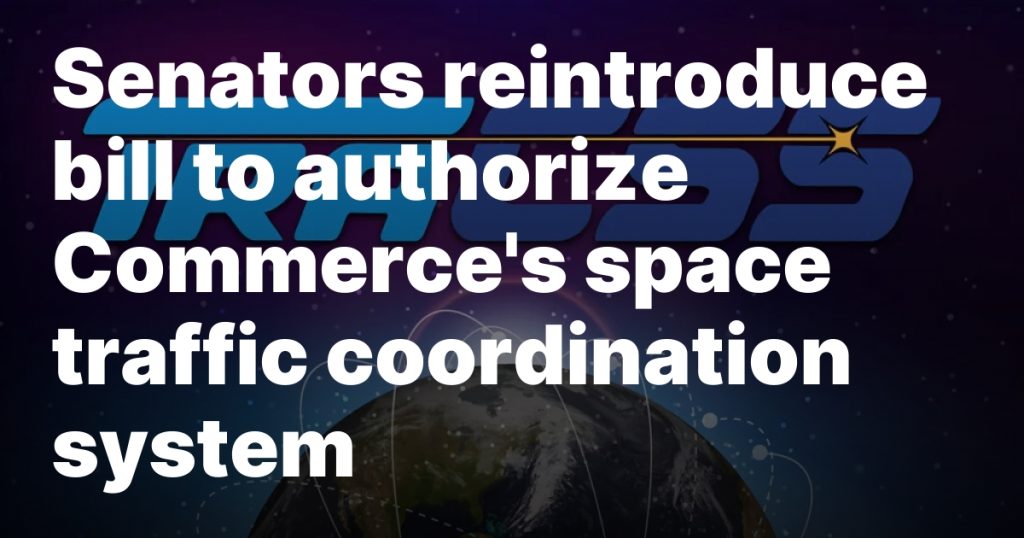WASHINGTON — A bipartisan group of senators has reintroduced a bill to formally authorize a space traffic coordination system being developed by the Office of Space Commerce.
The Situational Awareness of Flying Elements in Orbit Act, or SAFE Orbit Act, was introduced Feb. 5 by eight senators, led by Sen. John Cornyn (R-Texas). The other sponsors are Sens. Gary Peters (D-Mich.), Roger Wicker (R-Miss.), Marsha Blackburn (R-Tenn.), John Hickenlooper (D-Colo.), Mark Kelly (D-Ariz.), Eric Schmitt (R-Mo.) and Ben Ray Luján (D-N.M.).
The bill would formally authorize the creation of a space traffic coordination system at the Office of Space Commerce. The bill outlines the key aspects of the system, including providing a free public database and conjunction data messages but not more advanced services offered commercially. It would also give the office immunity from lawsuits arising from use of those services.
“The SAFE Orbit Act would prevent dangerous and costly accidental collisions in low Earth orbit and improve access to data collection and analysis to help propel the United States into the next phase of space exploration,” Cornyn said in a statement.
“The boom in commercial space activities has filled low Earth orbit with more debris and satellites than ever,” Hickenlooper said in that statement. “A cutting-edge traffic coordination system will help preserve our leadership in space.”
The approach outlined in the bill is something that the Office of Space Commerce has been implementing with its Traffic Coordination System for Space (TraCSS). That system started beta testing in September 2024 with a goal of having the system ready for full operations by September 2025.
Development of TraCSS dates back to Space Policy Directive 3 by the first Trump administration in 2018, which directed the Commerce Department to develop a civil space traffic management system that would take over work that had been done by the Defense Department. While Congress has appropriated funding to the office to develop TraCSS, it has not formally authorized the system, a move that would enshrine it in law and also provide the government with protection from lawsuits.
At the recent Smallsat Symposium, the Office of Space Commerce’s work on TraCSS got positive reviews. “The amazing thing is that we’ve got a regulatory agency getting prepared to coordinate all of the safety activities in space. It’s been needed for years,” said Dan Ceperley, founder and chief operating officer of LeoLabs, a commercial space tracking company that is among those working with TraCSS.
“The biggest challenge is timeline. The problem doubles ever 22 months,” he said on a Feb. 6 panel, referring to the growth in number of space objects. “So, we need to get this system online and operational as fast as possible so that then, in operational mode, its capacity can start doubling every 22 months. Time is of the essence.”
Tom Stroup, president of the Satellite Industry Association, echoed that assessment. “I think everybody would have loved to see it be accomplished sooner,” he said in a Feb. 5 panel. “They’ve done a very good job getting to where they are, but I think that probably everybody in the industry wish they’d been done five years ago.”
Besides formally authorizing TraCSS, the bill would also alter the Office of Space Commerce itself, elevating it from an office within the National Oceanic and Atmospheric Administration to a bureau reporting directly to the Secretary of Commerce. As a bureau, it would be led by an assistant secretary for space commerce, a position that would require Senate confirmation.
Some in the space industry have sought such a move, arguing that it would give the office a higher profile and potentially more resources than it has now inside NOAA. The bill would direct the Department of Commerce to elevate the office no later than five years after the bill became law.
A similar version of the bill, with the same title, was introduced by many of the same senators in early 2024. The bill cleared the Senate by unanimous consent in December, but was not taken up by the House before the end of the previous Congress.









As Schools Shrink, D.C.’s Public Pre-K Shows Lasting Enrollment Benefits – The 74
Posted 8 mints ago by inuno.ai